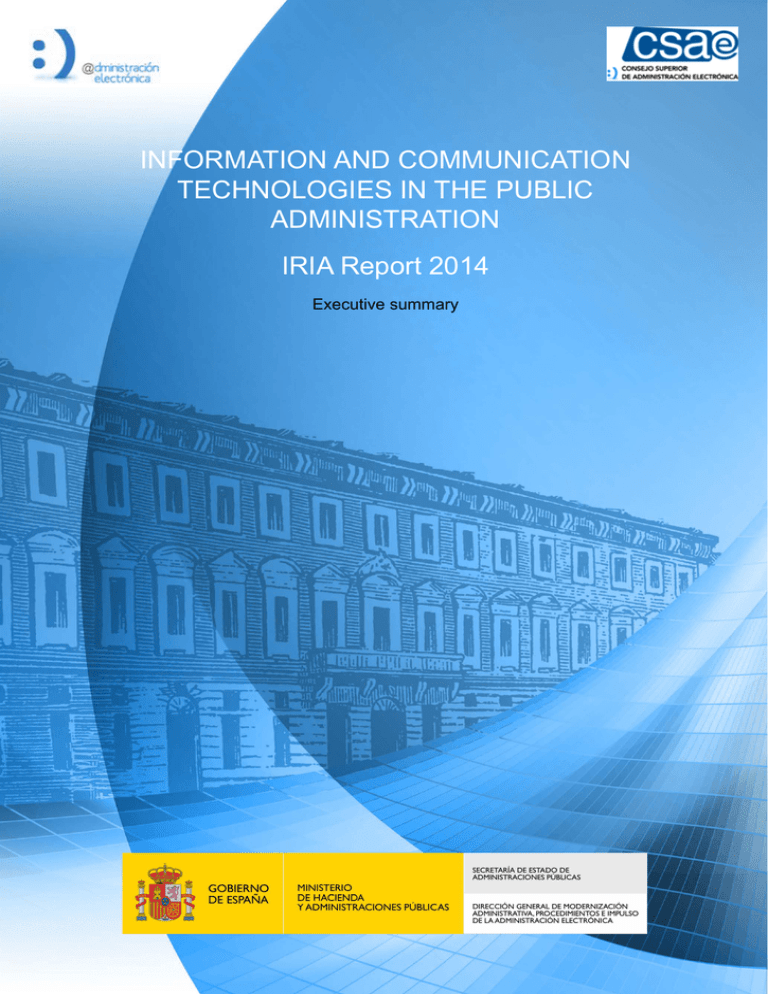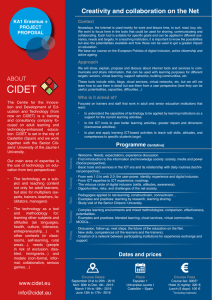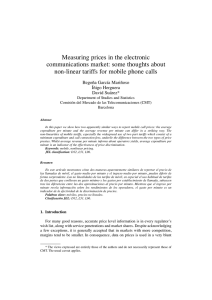Information and Communication Technologies in the Public
Anuncio

INFORMATION AND COMMUNICATION TECHNOLOGIES IN THE PUBLIC ADMINISTRATION IRIA Report 2014 Executive summary TITLE: Information and Communication Technologies in the Public Administration. IRIA report 2014. Executive summary TÍTULO: Las Tecnologías de la Información y las Comunicaciones en la Administración Pública. Informe IRIA 2014. Resumen ejecutivo This is a publication of the Directorate General for Administrative Modernization, Procedures and Promotion of eGovernment Dirección General de Modernización Administrativa, Procedimientos e Impulso de la Administración Electrónica (DGMAPIAE) July, 2014 Digital edition with Adobe Acrobat 5.0 Available online at Portal de Administración Electrónica (PAe): http://administracionelectronica.gob.es/ Published: © Ministry of Finance and Public Administration Technical Secretariat General Information, Documentation and Publications Unit Publications Centre Edita: © Ministerio de Hacienda y Administraciones Públicas Secretaría General Técnica Subdirección General de Información, Documentación y Publicaciones Centro de Publicaciones Publisher´s series: administración electrónica NIPO (Official Publication Identification Number): 630-14-182-4 GOVERNMENT OF SPAIN MINISTRY OF FINANCE AND PUBLIC ADMINISTRATION Information Technologies in the Public Administration Iria – Reina 2014 Contents INTRODUCTION ................................................................................................................................. 4 STATE ADMINISTRATION................................................................................................................... 5 ICT EXPENDITURE ......................................................................................................................... 5 IT EQUIPMENT .............................................................................................................................. 8 OPERATING SYSTEMS ................................................................................................................. 10 ICT STAFF .................................................................................................................................... 10 NETWORK ADMINISTRATION ..................................................................................................... 11 LOCAL GOVERNMENTS ........................................................................................................... 12 ICT EXPENDITURE ....................................................................................................................... 12 IT EQUIPMENT ............................................................................................................................ 13 OPEN-SOURCE SOFTWARE ......................................................................................................... 14 ICT STAFF .................................................................................................................................... 14 NETWORK ADMINISTRATION ..................................................................................................... 15 E-GOVERNMENT......................................................................................................................... 15 3 INTRODUCTION In compliance with the clauses of Royal Decree 589/2005, of 20 May, the High Council of E-Government should, among other functions, ‘act as an Observatory of E-Government, understanding its evolution and situation and suggesting adequate corrective measures whenever necessary.’ In order to perform this task, the Council’s Standing Committee collects ‘information on the technology, human, economic and procurement resources in information technologies’ and publishes regular reports on the results of its surveys on the E-Government Portal (PAe, after name in Spanish). http://administracionelectronica.gob.es/pae_Home/pae_OBSAE/pae_Informes.html In line with this, a new IRIA Report is being issued, analysing the most significant indicators of the current situation and use of Information and communication technologies and systems in the Public Administration, as well as of the development of e-Government. The IRIA Report covers the General State Administration and local governments, being a thorough study for the General State Administration and a sample analysis for local governments, including information on provincial governments, island councils and townships with more than 500 inhabitants. 4 STATE ADMINISTRATION ICT EXPENDITURE In 2013, €1,420 million were spent in the General State Administration in ICT, i.e. 2% less than in 2012. Telecommunications accounted for 24% of total expenditure, while the remaining 76% corresponded to IT. Breaking expenditure down by ministries, only three accounted for 30% total expenditure in telecommunications: Home Affairs (54%), Foreign Affairs and Cooperation (32%) and Development (32%). The share of IT expenditure in the total budget (Chapters 1, 2 and 6) was 3.83%, quite similar to that of 2012. The Ministries with the highest shares were Industry, Energy and Tourism, and Labour and Social Security (+10% for each). Breaking IT expenditure by items, we can see that hardware and software procurement went up, at the expense of IT services. Hardware accounted for 11%, considering both investment and equipment rental. The same share went for software, including the investment in system software and application packages but not custom applications. IT services took 45%, while staff expenses remained quite stable at 31%. Finally, consumables and miscellaneous expenditure (‘Others’) were estimated at 3% of the total expenditure in hardware, software and IT services. As to suppliers, IBM kept its leading position at 10% (28% in software). It was followed again by Indra, the main supplier of IT services (11% in this item). Hewlett-Packard and Fujitsu also kept their shares, the former being the leader in hardware supplies. The total investment in hardware in 2013 was €113 million. 56% of this went to devices; 25%, to PCs and 19%, to multi-user systems. Broken down by ministries, Home Affairs made a significant investment, reaching a share of 29% of the total investment. Together, this ministry, Labour and Social Security, and Finance and Public Administration accounted for 60%. Regarding software, the expenditure is as diversified as usual, with 27% in operating systems, 22% in information management systems and 14% in communications systems. Investment in IT services totalled €489 million in 2013, going down by 3% from 2012. While the Ministry of Education, Culture and Sports significantly raised investment in this item (over 50%), the Ministry of Defence reduced it (over 30%). Item distribution is similar to previous years. Application development and maintenance accounted for 47% total expenditure, while software and hardware support and maintenance hovered at 31%. The outsourcing budget – housing, hosting and user service, data transcription and digitisation – kept its 6% share. Finally, consulting services (organisation, technology, security) only accounted for 4% of the total expenditure in IT services, while training represented just 1%. 5 Regarding expenditure structure by ministries, most of them – with the exception of Food, Agriculture and Environment, Defence, and Home Affairs – spent the largest share in application development and maintenance. The total expenditure on telecommunication services was €340 million, 9% less than in 2012. As in previous years, more than 50% of the total amount corresponded to the Ministry of Home Affairs, whose budget was, in absolute terms, slightly smaller than in 2012. The other ministry with a significant share (more than 10%) is Labour and Social Security. Broken down by type of services, these were landline phones (23%), data transmission (32%), mobile phones (7%) and others (37%). It was often quite difficult to break down costs by type of services, so they were usually considered under the service with the highest share. The leading supplier was Grupo Telefónica, with a market share of 83%, followed far behind by BT España, which increased its share to 8%. All the other suppliers held shares below 1%. 6 ICT expenditure 2013 In thousands of euros IT expenditure Total Telecommunication expenses Ministry Hardware Software IT services Staff Others Total %V Food, Agriculture and Environment 4,579 6,924 19,132 11,871 919 4,057 47,481 3% Foreign Affairs and Cooperation 2,720 3,883 13,889 4,337 615 11,980 37,425 3% Defence 6,603 8,262 26,126 62,672 1,230 25,060 129,952 9% Economy and Competitiveness 13,255 9,797 37,081 19,340 1,804 8,023 89,299 6% Education, Culture and Sports 2,684 1,546 13,866 6,807 543 3,006 28,452 2% 18,702 12,183 134,881 48,390 4,973 36,168 255,297 18% 8,472 6,832 23,313 8,058 1,159 23,253 71,087 5% 15,902 47,958 79,535 84,453 4,302 28,312 260,462 18% 3,836 1,835 23,448 5,512 874 2,364 37,869 3% 33,101 11,744 40,085 66,200 2,548 182,043 335,720 24% Justice 3,626 2,670 52,054 6,320 1,750 9,868 76,288 5% Presidency 1,061 803 2,904 5,345 143 1,777 12,032 1% Health, Social Policy and Equality 3,771 2,941 23,086 4,016 894 4,156 38,864 3% 118,314 117,377 489,399 333,320 21,753 340,065 1,420,228 100% Labour and Social Security Development Finance and Public Administration Industry, Energy and Tourism Home Affairs Total %V Vertical percentage 7 IT EQUIPMENT As at 1 January 2014, the total number of equipments installed in the General State Administration was 492,129, with an average age of 5.2 years. The Ministry of Defence had 22% of the total equipment installed in the General State Administration. It was followed by the Ministry of Home Affairs, the Ministry of Finance and Public Administration, and the Ministry of Labour and Social Security. In terms of type of systems, almost 50% mainframe computers were to be found in the Ministry of Labour and Social Security and the Ministry of Home Affairs, while 53% servers corresponded to the Ministry of Labour and Social Security, the Ministry of Economy and Competitiveness, and the Ministry of Defence. Regarding personal computers, 86% were desktop computers, 11% were laptops and 3% were mobile terminals. 30% laptops were in the Ministry of Defence. As to the distribution of desktop computers, it was similar to that of PCs as a whole. Finally, the Ministry of Home Affairs had 27% mobile terminals. As to brands, 35% mainframe computers were from IBM; 27% were Sun and 20%, Fujitsu. The only equipment installed in 2013 was IBM (cf. Chart 3.11, Installed IT equipment). Servers were mostly supplied by Hewlett-Packard (44%), followed by Dell (12%) and IBM (8%). Hewlett-Packard was also the leading supplier of small systems (66%) and PCs (46%; 75% PCs installed in the General State Administration in 2013), Dell being the second largest PC supplier (14%). Installed IT equipment (evolution) 01/01/2010 Mainframe computers 01/01/2011 01/01/2012 Number of units 01/01/2013 01/01/2014 84 80 45 45 51 21,631 23,104 22,690 22,766 23,892 Personal computers 431,453 452,126 450,012 450,178 468,186 Total 453,168 475,310 472,747 472,989 492,129 Servers 8 Equipment by ministries 01/01/2014 Mainframe computers Servers Personal computers Total Ministry Number Defence %V Number %V Number %V Number %V 4 8% 3,310 14% 103,702 22% 107,016 22% 12 24% 1,696 7% 80,552 17% 82,260 17% 9 18% 2,560 11% 72,680 16% 75,249 15% 12 24% 5,795 24% 59,763 13% 65,570 13% Economy and Competitiveness 3 6% 3,583 15% 45,814 10% 49,400 10% Development 6 12% 2,252 9% 30,930 7% 33,188 7% 902 4% 18,816 4% 19,718 4% 699 3% 14,892 3% 15,596 3% Foreign Affairs and Cooperation 860 4% 13,035 3% 13,895 3% Education, Culture and Sports 855 4% 9,734 2% 10,589 2% Health, Social Policy and Equality 571 2% 8,400 2% 8,971 2% Industry, Energy and Tourism 592 2% 6,464 1% 7,056 1% Presidency 217 1% 3,404 1% 3,621 1% 23,892 100% 468,186 100% 492,129 100% Home Affairs Finance and Public Administration Labour and Social Security Justice Food, Agriculture and Environment Total 5 51 10% 100% %V.: Vertical percentage 9 OPERATING SYSTEMS The only mainframe computer installed in 2013 ran a z/OS operating system. Likewise, 51% of the servers installed last year had Windows OS; 12% relied on virtualisation and 8% had Linux. The distribution of PCs per operating system is quite similar to that of 2012, 98% of them running Windows OS (67% Windows 7, 13% Windows 8 and 6% Windows XP). ICT STAFF The global number of employees performing ICT-related tasks in the General State Administration as at 1 January 2014 was 11,487. 94% of them were career civil servants, while the remaining 6% were contract staff. In this report, the number of ICT-related staff for the Ministry of Defence was significantly lower, since it only includes the staff performing tasks related with the general purpose network, in line with the guidelines for the rest of the report. 23% worked in the Ministry of Economy and Finance, followed by the Ministry of Defence (18%). Thus, the 8% fall in the global number comes to 4% when the Ministry of Defence is not taken into account. 24% these employees worked in the Ministry of Finance and Public Administration; 21%, in the Ministry of Home Affairs and 19%, in the Ministry of Defence. All other ministries accounted for less than 15% individually. The ICT staff/total staff ratio was 2.09% globally, which means it was slightly lower than in 2012. ICT/total staff ratio 01/01/2014 Ministry ICT staff Finance and Public Administration Total staff ICT/total staff ratio 2,756 48,536 5.68% Presidency 173 3,341 5.18% Industry, Energy and Tourism 170 3,692 4.60% Food, Agriculture and Environment 429 10,418 4.12% 1,663 45,090 3.69% Economy and Competitiveness 689 24,703 2.79% Health, Social Policy and Equality 142 6,724 2.11% Foreign Affairs and Cooperation 158 7,535 2.10% Education, Culture and Sports 241 14,228 1.69% Defence 2,192 145,717 1.50% Home Affairs 2,393 182,594 1.31% Development 281 30,437 0.92% Justice 200 27,224 0.73% 11,487 550,239 2.09% Labour and Social Security Total 10 NETWORK ADMINISTRATION Analysis of the indicators showing the use of ICTs in the General State Administration. As at 1 January 2014, there were 85 computers every 100 public servants in the General State Administration as a whole, a ratio 5% higher than in the previous edition of this report. In the case of administrative workers (excluding security forces, teachers and health professionals), the number was 171 computers every 100 public servants. This had to do with the fact that the equipment included computers in workers’ offices and training facilities, as well as laptops and mobile devices. 90% personal computers were connected to the Intranet, a figure similar to that in the past report. As to PCs connected to the Internet, their percentage remained stable at 86%. In several ministries, almost every PC was connected to the Internet. The number of computers connected to the Internet every 100 public employees rose slightly to 73. As to the number of computers connected to the Intranet rose more sharply, 3 points, to 76 every 100 public employees. A new aspect analysed in this report is the distribution of mailboxes per ministry and the software used. The total number of mailboxes (both own use and lent to third parties), was 611,165. The Exchange technology was the most commonly used in all ministries. The total number of public servants who had an e-signature was 350,838, i.e. 64% of all workers. This number is 8% higher than the total for the previous two-year period. Most ministries saw increases in this item, with Industry, Energy and Tourism reaching 100%, and Finance and Public Administration being close to it (98%). For the analysis of telecommuting, only those employees working part- or full-time out of the office and accessing the information systems of the Public Administration were taken into account. This work arrangement is not really widespread in the General State Administration: only 4,663 workers, i.e. almost the same as in the past report and less than 1% of the total workforce. 11 LOCAL GOVERNMENTS ICT EXPENDITURE The total ICT expenditure for local governments was €813 million, almost 5% less than in 2011. When discussing absolute figures, it must be borne in mind that this edition of the report includes the three Provincial Governments of the Basque Country (included only in part in 2011). Since their competencies are significantly different from those of other provincial governments, their expenditure was higher. As a result, the global absolute expenditure for provincial governments, councils and island authorities was 8% higher than in 2011. On the other hand, the total expenditure at the level of townships went down by almost 9%. 23% expenditure (a little over €180 million) went to telecommunications; the remaining 77% was IT expenditure. Telecommunication services included voice and data transmission but no communication hardware, which was part of IT expenditure. As in past editions, stratified expenditure showed that small townships spent a larger share of their ICT budget on telecommunications than large townships or provincial governments. The indicator reflecting the ICT expenditure share in the total budget of local governments (Chapters 1, 2, 6) was 1.97%, a 0.13% increase over 2011. This slight increase can be associated to the shrinking of total budgets in all strata. This indicator performed irregularly at the various categories, without showing significant variation in any of them. The global ICT expenditure/population ratio was €13.53/inhabitant on average, 8% less than in the previous report. In fact, this indicator decreased in all strata. Variation between categories sharpened. In 2013, the total IT expenditure by local governments was €629 million, i.e. 2.8% less than in 2011. Investment in software went moderately up, while hardware expenditure decreased considerably. As to ICT staff, the shares remained stable, whereas IT service expenses rose significantly. Regarding the evolution of IT expenditure in the past few years, steady growth until 2007 was followed by a downward trend showing a 16% fall in the 2007-2013 period. The fall since 2011 could be observed in all township categories, although they were not as sharp as in the past report. 12 ICT expenditure 2013 In thousands of euros IT expenditure Local governments Hardware Software Provincial governments, councils and island authorities > 500,000 inhabitants T O W N S H I P S IT services Staff Others Telecommunication expenses Total 16,571 16,791 79,663 44,115 3,391 25,833 186,364 9,781 13,633 47,879 56,975 2,139 16,659 147,067 13,176 11,280 39,939 54,271 1,932 29,228 149,826 30,000-100,000 inhabitants 9,548 7,493 24,264 41,672 1,239 32,356 116,572 10,000-30,000 inhabitants 10,330 7,173 20,275 35,739 1,133 30,464 105,115 5,000-10,000 inhabitants 3,928 2,244 8,736 10,532 447 16,908 42,794 2,000-5,000 inhabitants 2,999 2,223 4,739 10,521 299 16,817 37,598 1,000-2,000 inhabitants 1,557 489 1,908 2,710 119 9,075 15,857 684 490 2,945 1,413 124 6,299 11,954 68,574 61,816 230,349 257,948 10,822 183,639 813,148 100,000-500,000 inhabitants 500-1,000 inhabitants Total IT EQUIPMENT With regard to the availability of IT equipment by type and township categories, the global number of mainframe computers dropped, whereas the number of medium-scale systems rose. As to the number of servers and personal computers, it decreased slightly. The number of equipments went down in all township categories except for townships with 10,000 to 100,000 inhabitants. IT equipment 01/01/2014 Local governments Provincial governments, councils and island authorities > 500,000 inhabitants T O W N S H I P S Mainframe computers Medium-scale systems Personal computers Servers 9 85 3,413 43,443 2 19 903 40,290 100,000-500,000 inhabitants 3 101 2,492 61,400 30,000-100,000 inhabitants 2 58 3,611 63,340 10,000-30,000 inhabitants 40 2,946 57,337 1,000-10,000 inhabitants 125 3,489 59,438 545 7,189 17,399 332,438 500-1,000 inhabitants Total 17 429 Regarding access to broadband at the workplace, the figures were similar to those in the past edition of this report. About 94% to 97% workplaces in the three upper categories had access to broadband. In townships with 10,000 to 100,000 inhabitants, the percentage was about 90%, while for the two lowest categories it was about 55%. (Broadband: speed of at least 1,024KB/sec.) 13 Percentage of workplaces with broadband access 01/01/2014 % workplaces with broadband access Local governments Provincial governments, councils and island authorities T O W N S H I P S 94 > 500,000 inhabitants 97 100,000-500,000 inhabitants 97 30,000-100,000 inhabitants 90 10,000-30,000 inhabitants 89 1,000-10,000 inhabitants 56 500-1,000 inhabitants 55 OPEN-SOURCE SOFTWARE The report analysed the percentage of use of open-source software in multi-user systems and PCs taking two elements into account: operating systems and installed applications. About 25% multi-user systems used open-source software in both applications and operating systems. The highest percentage in this respect corresponded to provincial governments. As to personal computers, this percentage went up to 41% for applications (up to 86% in larger townships) and down to 8% for operating systems. ICT STAFF The global number of employees doing ICT-related tasks in local governments, considering civil servants, contract staff and employees of public sector companies remained similar to the 2011 figure. In the case of provincial governments, councils and island authorities, the number rose by 10%, in part due to the inclusion of all Basque provincial governments. It also increased for townships with 30,000 to 500,000 inhabitants. The costs of state-owned corporation employees appeared under IT services rather than staff expenditure. The ICT staff/total staff ratio rose slightly by 0.07, going down in all township categories with less than 30,000 inhabitants and up in all other strata. 01/01/2014 ICT staff Local governments ICT staff Provincial governments, councils and island authorities > 500,000 inhabitants T O W N S H I P S ICT/total staff ratio 1,952 3.82% 1,091 2,01% 100,000-500,000 inhabitants 1,505 1,71% 30,000-100,000 inhabitants 1,211 1,46% 10,000-30,000 inhabitants 1,063 1,05% 1,000-10,000 inhabitants 1,150 1,10% 74 0,77% 8,046 1.64% 500-1,000 inhabitants Total 14 As to the number of personal computers every 100 public employees, it remained at 68, with increases in all the upper categories and slight falls for the two lowest categories, more sensitive to sample size. NETWORK ADMINISTRATION At the level of local government, 96% personal computers were connected to the Internet – 6% more than in 2011. All categories showed a positive evolution of this indicator. As for personal computers connected to the Intranet, their number was 2% higher than in 2011. This indicator performed positively in all categories except in townships with 10,000 to 30,000 inhabitants. A total 88,403 employees used an e-signature for the exercise of their functions. They accounted for 18% staff (+4%). Their number grew in all categories but in smaller townships, with a sharper increase in the upper levels. Finally, only 1.31% public employees, i.e. 6,429 globally, were reported to use telecommuting. The percentage continued to be very low both globally and per categories. E-GOVERNMENT Already in 2011, almost 100% townships with more than 10,000 inhabitants had their own web portals. The upward trend continued for small townships. All townships with more than 500,000 inhabitants and 80% townships with 100,000 to 500,000 had their own e-offices and e-registries. About 65% provincial governments, councils and island authorities were reported to offer administrative procedures that could be fully processed online. This meant significant progress over 2011. 100% large townships offered census registration online. Other services offered were payments of property tax and vehicle tax. The smaller the township, the lower degree of implementation of these services. However, figures showed progress in all categories. Finally, the number of centres with public Internet access every 10,000 inhabitants was 2.65, while the number of Internet access points every 10,000 inhabitants was 12.54. 15


